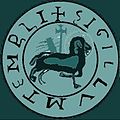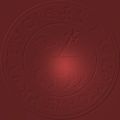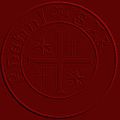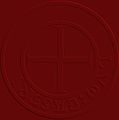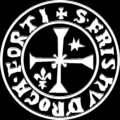|
Seal of the grand master of the Knights Templar
The Grand Masters of the Knights Templar during the later 12th and the 13th century used a double-sided seal which showed a representation of The Dome of the Rock (or a circular dome of the Church of the Holy Sepulchre) on one side, and the Order's symbol of two knights on one horse on the other side. This design is first attested as in use by Bertrand de Blanquefort, the order's sixth Grand Master, in 1158, forty years after its foundation, and it remained in use until the dissolution of the order in 1312. There was also a smaller, single-sided seal, which showed the Dome of the Rock (or the Holy Sepulchre), only.[citation needed] Different seals were used by provincial masters of the order. According to a papal bull issued by Innocent IV in 1251, it was customary for successive provincial masters to use the same seal. The master of Provence continued to use an Agnus Dei seal, while the seal of the Aragonese master William of Cardona and his successors depicted a knight on horseback, carrying a lance and shield, on which was a cross bearing the legend: S. MINISTRI TEMPLI 1 ARAGON 7 CATALON ("Seal of the minister of the Temple in Aragon and Catalonia"). Templars Seal Themes
The reverse of Bertrand de Blancafort's seal, Master of the Temple 1168 in Staatsarchiv Amberg The reverse of Grand Master William of Chartres seal from 1214 also depicts the Dome of the Rock. In heraldry, a Lamb of God (or paschal lamb, or agnus Dei) is a lamb passant proper, with a halo or charged with a cross gules, and the dexter forelimb reflexed over a cross staff from which a pennon of St. George (Argent a cross gules) is flotant. The seals of the Masters of the Temple in England: of Aimery de St Maur, 1200, Robert of Sandford, 1241, Richard of Hastings, 1160–85, and William de la More, 1304, showed the agnus Dei. SIGILLVM TEMPLI The obverse of a seal used by William de la More, master, 1304, resembles the above text . The reverse, a small oval counter-seal, with beaded borders, shows on the right a couped bust of a bearded man wearing a cap. and have the legend:— TESTIS SUM AGNI ("I am a witness to the Lamb") William de la More, styled frater Willelmus de la More miliciae. The seal is called commune sigillum capituli. The seal symbolic of their vow of poverty, showing two knights riding on one horse appears only to have been used by the order in France; there is no example of its use in England. Some of the seals of the English Templars were a semi-typical Pascal lamb bearing sometimes, not the flag of St George (or the cross), but the Beauseant, the battle banner of the order.
Other seals: Durham Cathedral Muniments, Medieval Seal G&B reference number: 3388 Knights of the Temple 1304 Description: Round. The Holy Lamb with banner. The Two RidersThe symbol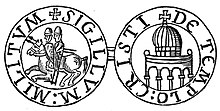 The Templar Seal showing two knights (perhaps Hugues de Payens and Godfrey de Saint-Omer) on one horse. There are many interpretations of the symbolism of this seal.
The image of two knights on the horse was widely used:
The LegendThe seals of the Grand Masters have textual differences:
While Vichiers' motto is written in Latin, the word 'Christ' begins with Greek letters (Chi Rho) (Latin symbol, XP) rather than the Latin CHR. The XP symbol arose early in Christianity and entered popular usage after the legendary pre-battle vision of Chi Rho and Christian conversion of the 4th century Roman Emperor Constantine. From the time of Constantine, XP was a significant symbol of Christianity, surpassed only by the cross itself. Early military associations make Chi Rho an apt symbol for the Templars. On de Vichiers' seal, Chi Rho is visible on the shields of the knights. The Double-Headed Eagle is more commonly associated with Coat of Arms of the Byzantine Empire. Bertram von Esbeck, Master of the Temple in Germany, 1296 depicts an eagle with two six-pointed stars.[citation needed] Paris TempleCrossAragon;Tortosa; Late 13th century. Depicting a cross. Legend: SIGILLUM MILICIE TEMPLI IN DERTOSA Aragon; Alfambra; 1248. Brown wax, round, 30 mm. in diameter, depicting a cross. Legend:......LUM CASTRI.... A cross having arms narrow at the inner center, and very broad at the other end.
Cross pattée and fleur-de-lisA seal from Provence: the Templars from Roaix, Sérignan ... This knight, Giraud de Chamaret, hoists the templar cross and the "fleur-de-lis". 1234.
Knight on the HorseThe seal of Brother Roustan de Comps, commander of the Order of the Temple at Richerenches, 1232, shows a single knight on horseback, bearing a shield with a cross: probably St. George.
HeadSeals of Brother Widekind, Master of the Temple in Germany, 1271, and Brother Frederick Wildergrave, 1289, showed Christ's head (or John the Baptist's head by other opinions) Tower or CastleThe seal of Templar officials in Yorkshire c.1300 shows a tower with a pointed roof.
Aragon; Monzón; Early 14th century. Round, depicting a castle with three towers, with a griffin on each side. Legend: S. CASTELL........ONI. Aragon; Huesca; Round, depicting a castle. Legend: S. DOM. TEMPLI DE OSCA Aragon; Barbará; Early 14th century. Yellow wax, round, 29 mm. in diameter, depicting a castle between two fishes. Legend: S. COMMAND.....BARBERA Chateau de GuilleraguesHere is a Templar cross found in the oldest tower of Château de Guilleragues in the Aquitaine region of France.
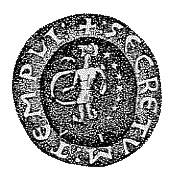 The word Abraxas (or Abrasax or Abracax) was engraved on certain antique stones, called Abraxas stones, which were used as amulets or charms by Gnostic sects. The image most associated with Abraxas is that of a composite creature with the head of a rooster, the body of a man, and legs made of serpents or scorpions; carrying a whip and shield. The Gnostics identified Abraxas with Yahweh (under the Greek form "IAO"). Amulets and seals bearing the figure of Abraxas were popular in the 2nd century, and these stones survived in the treasuries of the middle ages. Abraxas appears on the seal of a Templar Grand Master in a French charter dated 1214. The Templars' use of Abraxas as a seal was most likely a result of their expansive treasuries containing a number of ancient gemstones.[2]
Star and Crescent Moon
LionSeals of Brother Otto of Brunswich, commander of Supplingenburg, shows a lion; A seal of one Knight Templar, England, 1303 is showing the Lion of England and the cross pattée and the crescent moon of the Mother Goddess with stars. Aragon; Miravet; 1278, 1287. Depicting a lion GriffonWilliam, Master of the Temple in Hungary and Slovenia, 1297, depicts a winged griffon Unusual uncertified early Templar insignia
References
Wikimedia Commons has media related to Templars Seal.
|


